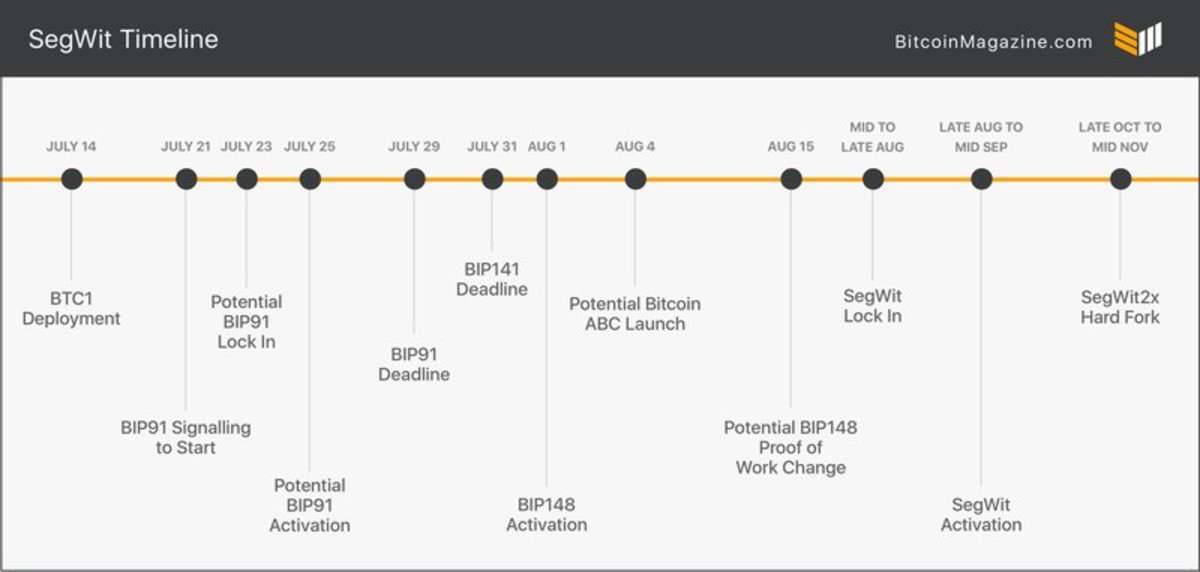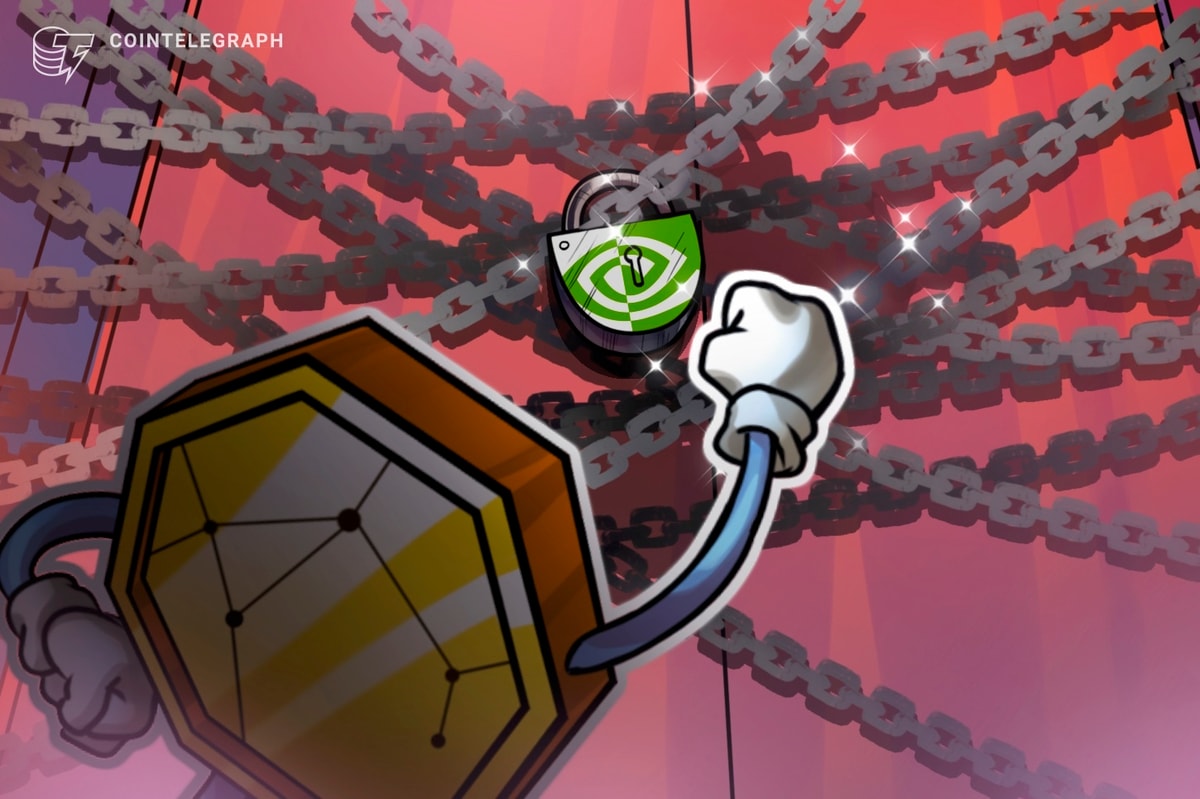
Bitcoin’s very public scaling debate is entering a crucial phase. Two of the most popular scaling proposals available today — BIP148 and SegWit2x — both intend to trigger Segregated Witness (“SegWit”) activation within a month, which means that the protocol upgrade could be live within two.
At the same time, there is a very real risk that Bitcoin “splits.” Both BIP148 and SegWit2x could diverge from the current Bitcoin protocol, which could in turn lead to even more splits.
Here is a list of dates for July, August and beyond to keep an eye on.
This article was last updated on August 8th.
Recap: Segregated Witness Activation
August 2nd update: Most of the information in this section is still accurate, but some of it is a bit outdated now. Keep in mind it was written about a month ago, before many of the recent developments occurred.
First, a brief recap on Segregated Witness and its potential activation methods.
SegWit is a backwards compatible protocol upgrade originally proposed by the Bitcoin Core development team. It has been a centrepiece of the scaling roadmap supported by Bitcoin Core since the protocol upgrade was first proposed in December 2015, and it is implemented on many active Bitcoin nodes on the network today. SegWit is now also part of the “New York Agreement”: an alternative scaling roadmap forged between a significant number of Bitcoin companies, including many miners. And Bitcoin Improvement Proposal 148, or BIP148, is a user activated soft fork (UASF) scheduled for August 1st that also intends to activate SegWit.
The difference lies in how the activation should happen.
The first and original option was proposed by the Bitcoin Core development team. Their SegWit code, defined by BIP141, activates if 95 percent of hash power within a single difficulty period of about two weeks signals readiness before November 15th. Assuming that the miners who signal readiness are actually ready to support the upgrade, risks of a split in Bitcoin’s blockchain and currency are minimal.
However, currently only some 40 to 45 percent of hash power is signaling readiness for BIP141. This is why a segment of Bitcoin users plans to activate SegWit with the BIP148 UASF. Starting on August 1st, their nodes will reject all blocks that do not signal readiness for BIP141. If this proposal is supported by any majority of miners (by hash power), these miners should always claim the longest valid chain, which should activate SegWit on all SegWit-ready Bitcoin clients and avoid a split. But if this proposal is supported by a minority of miners, a “BIP148 chain” would split off from the current protocol.
The New York Agreement, also referred to as the “Silbert Accord” or “SegWit2x,” plans to activate SegWit through BIP91. Like BIP148, all BIP91 nodes would reject any blocks that do not signal readiness for BIP141. But unlike BIP148, BIP91 nodes would only do this once 80 percent of hash power signals that they support BIP91, within a period about two days. This should also minimize the chance of a split.
However, the second step of the New York Agreement is a hard fork to double Bitcoin’s “base block size.” This change, as opposed to Segregated Witness itself, is not backwards compatible, and could therefore lead to a “split” as well.
There is also such a thing as miners signaling intent to support the New York Agreement, but this is effectively meaningless and will be ignored for the purpose of this article.
Now for the dates…

July 14: BTC1 Deployment
The software client that resulted from the New York Agreement is a fork of the Bitcoin Core codebase, called “BTC1.” BTC1’s beta software was released on June 30th. But according to the SegWit2x roadmap, July 14th is the day that signatories to the New York Agreement should actually install the BTC1 beta software and test it for themselves.
This shouldn’t affect regular users or miners much, however.
July 17th update: Deployment of BTC1 is delayed by a couple of days, but not in such a way as to distort the remainder of the timeline.
July 21: BIP91 Signaling to Start
The SegWit2x development team aims for July 21st to be the day that BTC1 nodes are actually up and running, and, importantly, the day that miner signaling should commence.
This shouldn’t really affect regular users either.
But if you are a miner, you may want to help activate SegWit by signaling readiness for BIP91. (This is done by mining “bit 4” blocks; for example, by mining with BTC1 or with Bitcoin software that includes a BIP91 patch.)
July 17th update: Several mining pools have already started signaling support for BIP91, even before the announced signaling date. At the time of publication of this update, the hash power threshold has not yet been met, however.
July 21st update: BIP91 is now locked in. See below.
July 23 (at the earliest): BIP91 Lock In
The precise threshold for BIP91 activation requires that within a pre-defined series of 336 blocks, 269 blocks must signal readiness. That’s some 80 percent of hash power, over about 2 1/3 days. So assuming the SegWit2x roadmap is followed, BIP91 could, at the very soonest, lock in on July 23rd.
Again, this shouldn’t really affect regular users.
But if you are a miner and BIP91 does activate, you now have another day or two to comply with the BIP91 soft fork. If you don’t, you risk mining invalid blocks.
July 17th update: Since a number of mining pools have started to signal support for BIP91 early, the earliest BIP91 lock-in date has moved forward, too.
July 21st update: BIP91 is now locked in. See below.
July 25 (at the earliest): BIP91 Activation
On July 25th, another 336 blocks after BIP91 “lock in”, BIP91 could actually go into effect, at the soonest. Any blocks that do not signal readiness for Segregated Witness (per BIP141) should now be rejected by a majority of miners (by hash power).
This still shouldn’t really affect regular users.
But if you are miner, you should now only mine blocks, and only mine on top of blocks, that signal readiness for SegWit (BIP141). Else you risk having your blocks rejected by a hash power majority.
July 17th update: Since several mining pools have started to signal support for BIP91 early, the earliest BIP91 activation date has moved forward too.
July 21st update: The 80 percent hash power lock-in threshold for BIP91 was reached today (UTC). This means that BIP91 should activate on July 23rd. If at least a majority of miners (by hash power) actually does enforce BIP91 for the next couple of weeks, this should make BIP148 obsolete. For more information, see this article.
August 8th update: BIP91 and/or BIP148 have done its job: Segregated Witness (BIP141) is no past the point of return for lock-in. See below.
July 29: BIP91 "Deadline"
If Bitcoin miners want to be sure to avoid a “split” in Bitcoin’s blockchain and currency as a result of BIP148 activation, July 29th is a first deadline day for them.
July 17th update: Since the next deadline is already missed (see below), July 29th is now the second deadline day for miners, not the first.
To ensure that BTC1’s BIP91 is activated in time to be compatible with BIP148, it should be locked in on this day at the very latest, say, before 08:00 UTC. (That’s 4 am on the U.S. east coast.) But sooner is better: The closer to the deadline BIP91 locks in, the bigger the risk it doesn’t activate in time.
If BIP91 has not activated by this deadline, Bitcoin may well be heading for a chain-split.
If this happens, and if you are a regular user, and you haven’t prepared for a potential BIP148 UASF chain-split yet, you now have two days left to do so. And you really should. This article explains how.
If BIP91 has not activated by July 29th and you are a miner, you now have two days to decide on which chain you will mine on August 1st: on the BIP148 chain, or on the original (“Legacy”) chain. July 17th update: Or perhaps on the Bitcoin ABC chain; see below.
July 21st update: BIP91 is now locked in. See above.
July 31: BIP141 "Deadline"
If Bitcoin miners want to be sure to avoid a “split” in Bitcoin’s blockchain and currency as a result of BIP148 activation, July 31st is technically the miners’ second deadline day to avoid a split.
On this day (UTC), at the very latest, either BIP91 must activate, or BIP141 must lock in. In other words, if BIP91 did not lock in in time, there must now have been a two-week difficulty period in which 95 percent of hash power signals support for SegWit.
In reality, the chance is small that July 31st actually coincides with the closing day for a difficulty period. And even if it does, it’s unlikely that it will take until this day before it’s clear whether the 95 percent threshold will be met.
As such, both users and miners should have probably already prepared for a potential split, as explained for July 29th. But July 31st really is your last chance to get ready.
July 17th update: As of July 15th, this deadline can no longer be met.
August 1: BIP148 Activation
This is the day BIP148 activates, which makes it the third and final deadline day for miners to avoid a split.
On August 1st, at 00:00 UTC (note that this is still July 31st in the U.S.), all BIP148 nodes will start rejecting any blocks that do not signal readiness for Segregated Witness (per BIP141). If Bitcoin Core’s BIP141 or BTC1’s BIP91 have locked in and/or activated in time, there should be no chain-split.
If neither has happened, a majority of miners (by hash power) now have one last chance to avoid a chain-split: by supporting BIP148 themselves. This would ensure they always (re-)claim the longest valid chain according to all current Bitcoin nodes, and will activate SegWit through BIP141.
If BIP141, BIP91 nor BIP148 have attracted sufficient hash power by August 1st, but BIP148 does gain some traction, the chain could split on this day. If that happens, there will be two types of “Bitcoin,” which we’ll refer to as “148 Bitcoin” or “148BTC” for the BIP148 side of the split, and “Legacy Bitcoin” or “LegacyBTC” for the other side. (This split could resolve over time if 148 Bitcoin ever reclaims the longest chain, or if 148 Bitcoin is abandoned by all miners and users for good, but this is not the focus of this article.)
If you own bitcoin (that is: private keys) at the time of split you should automatically own both 148BTC and LegacyBTC. Though, to access both types, you probably need to download new software. That said, if you are a regular user, it is probably best to initially halt any and all transactions, at least until the situation is more clear. Failing to do so may cost you money! For more information, see this article.
If a split happens and you are a miner, you should have by now decided on which chain you’ll mine, and mine on that chain. (Of course, you can still switch at any time. You may simply want to mine the most profitable chain, for example.)
July 21st update: The 80 percent hash power activation threshold for BIP91 was reached today (UTC). This should make BIP148 obsolete. However, if a majority of hash power does not actually enforce BIP91 by August 1st, the scenario described here does still hold up. For more information, see this article.
August 2nd update: BIP148 has now activated, and so far all is going well. Miners are mining SegWit-signaling blocks-only, which is compatible with both BIP91 and BIP148, which means that all Bitcoin nodes are united on one chain. Segregated Witness (BIP141) is currently scheduled to lock-in on August 8th.
August 8th update: Segregated Witness (BIP141) is now past the point of no return for lock-in. All Bitcoin nodes are still united on one chain.
August 4: Potential Bitcoin ABC Launch
Although the exact date is not set in stone, August 4th may see the introduction of a new type of “Bitcoin”: Bitcoin ABC.
Major Bitcoin mining hardware producer Bitmain recentlyannounced that if BIP91 does not activate before August 1st and BIP148 is showing signs of life after August 1st, it will launch a “contingency plan.” More recently, the implementation to embody this contingency plan — named “Bitcoin ABC” — was announced at the Future of Bitcoin conference.
Bitcoin ABC will share a common history with Bitcoin up until August 1st, but will, for the first couple of days after that, probably be privately mined by Bitmain. It will also include several new and incompatible protocol rules, perhaps most importantly an increased block size limit.
If you owned bitcoin at the time of split — August 1st, 00:00 UTC — you should automatically own “Bitcoin ABC” as well. But you may, in that case, need to download software to be able to send (and receive) the coins. More information will likely become available if this event occurs.
If you are a miner you should be able to mine Bitcoin ABC on August 4th. (And perhaps sooner.)
July 17th update: It now seems a bit more likely that Bitcoin ABC will launch, regardless of BIP148. This launch is scheduled for August 1st, 12:20 (PM). It may still take a couple of days before Bitcoin ABC becomes widely accessible for miners and users. At least one mining pool and exchange, China-based ViaBTC, has announced support for the coin, which it will list as "Bitcoin Cash", with the ticker "BCC".
July 21st update: Contraryto earlier reports, it appears that Bitcoin ABC will not include two-way replay protection. If you want to make sure you don't lose access to your Bitcoin ABC coins, you should not send any bitcoins (whether 148BTC or LegacyBTC) until you have "separated" your Bitcoin ABC coins. For more information, see this article. (Also note that Coinbase has explicitly stated that users will not have access to their Bitcoin ABC coins.)
August 2nd update: Bitcoin Cash (BCH), as the new cryptocurrency is now called, launched yesterday. While the project is off to a slow start when it comes to hash power and blocks, trading has opened, and it seems as if the coin could make it.
August 8th update: Bitcoin Cash (Bcash; BCH) is alive and well as an alternative cryptocurrency.
August 15: Potential BIP148 Proof-of-Work Change
While this date is not set in stone either, August 15th could see the introduction of yet another type of “Bitcoin,” which we’ll refer to as “NewPoW Bitcoin” or “NewPoWBTC.”
As a UASF, August 1st’s BIP148 fork should initially be effectuated by users — not miners. Users would start to reject any blocks that do not signal readiness for Segregated Witness (per BIP141). This should incentivize miners to follow the BIP148 chain (ideally, at least for BIP148 users, to the point where it’s the only chain left). But whether this will actually happen remains to be seen. So far, few miners have publicly indicated they will support the UASF.
If miner support on 148 Bitcoin remains low, (some of) its users may opt to implement a hard fork to change the proof-of-work algorithm. This would “fire” the existing group of miners by making their specialized ASIC mining hardware obsolete on the BIP148 chain, and could open the door for new miners — possibly re-decentralising the mining ecosystem back to home users with CPUs or GPUs. (At least temporarily.)
An open BIP148 “working group” on a channel of the "Bitcoin Core Community" Slack is currently working out the details to be proposed. But it seems that if by August 15th less than 15 percent of total hash power mines on 148 Bitcoin, this hard fork will be deployed. This would make the split with “Legacy Bitcoin” definite. It could technically also lead to another split on the 148 Bitcoin side, if some of its users decline to join the hard fork that changes the proof-of-work algorithm.
If you are a regular user and owned bitcoin at the time of the August 1st split, and you didn’t spend any until August 15th, you should now also own NewPoWBTC. If you bought or earned 148BTC between August 1st and August 15th, you should now (also) own NewPoWBTC.
But if you did spend bitcoins on any side of the split, that’s not as certain. Again, if you want to be on the safe side, don’t transact at all until the situation becomes more clear. (For more information, see this article.)
If you are one of the few miners that was mining on 148 Bitcoin with ASIC hardware, you may now want to point your hardware elsewhere — or shut it down completely. (This depends, of course, on whether or not it’s still profitable to mine 148BTC or anything else.)
And of course, anyone should by now be able to mine on NewPoWBTC without specialized ASIC hardware.
August 2nd update: As BIP148 has locked in and Segregated Witness seems increasingly likely to activate smoothly, there will almost certainly not be any proof-of-work change any time soon.
August 8th update: Segregated Witness (BIP141) is now past the point of return. BIP148 is virtually made obsolete, and a proof-of-work change will (almost certainly) not be needed.
Mid- to late- August: SegWit Lock In
If miners avoided a chain-split through BIP141, BIP91 or BIP148, Segregated Witness should at the latest lock in between mid-August or late August. This should be a bit a non-event if it happens through BIP91 or BIP148, as it would at this point be expected, and wouldn’t change much for anyone.
But what the lock-in means is that all SegWit-ready clients will start enforcing the new rules in the next difficulty period: after another two weeks. So if you are a regular user and would like to use the new features or want to maintain top-notch security, you now have two weeks to upgrade to software that enforces SegWit.
If a chain-split is not avoided, the situation could become far more complex. By mid-August, there could potentially be one, two, three or maybe even four “Bitcoins”: “148 Bitcoin”, “NewPoW Bitcoin”, “Bitcoin ABC,” as well as “Legacy Bitcoin”.
At the time of writing this article, it’s hard to say how best to deal with this situation. For a regular user, it’s always best to hold onto your private keys, and it’s probably best not to transact at all until the situation resolves in some way or another. (For more information, see this article.)
For a miner, it’s probably best to just mine the most profitable chain.
August 2nd update: Segregated Witness lock-in is currently scheduled for August 8th. (The exact time and date depends on how fast new Bitcoin blocks are found.)
August 8th update: Segregated Witness (BIP148) is now past the point of no return for lock-in. (Technically, it will lock-in tomorrow; this is now virtually guaranteed.)
Late August to Mid-September: SegWit Activation
If a chain-split is avoided by miners, SegWit should activate around this time. If you’re running a compatible client by now, you can begin to enjoy the new features while maintaining top-notch security.
If a chain-split is not avoided, the situation is (still) too complex to predict.
August 2nd update: Segregated Witness activation is currently scheduled for around August 23th. (The exact time and date depends on how fast new Bitcoin blocks are found.)
August 8th update: Segregated Witness activation is still scheduled for around August 23th. (The exact time and date depends on how fast new Bitcoin blocks are found.)
Late October to Mid-November: SegWit2x Hard Fork (see update)
Toward the end of this year (though potentially even up to early 2018), the hard fork part of SegWit2x should take place. To be exact, this hard fork activates on BTC1 clients three months after SegWit locks in. This activation means that a “base block” bigger than 1 megabyte should be mined, which makes BTC1 clients incompatible with all Bitcoin clients that do not have the hard fork code implemented.
At this point in time, it seems almost certain that not everyone will change their software to support this hard fork. Bitcoin’s development community in particular has almost unanumously rejected the proposal, while several companies have indicated their intentions not to support the change, and not all users seem on board either. As such, this could lead to another chain-split. (Theoretically, this could lead to the fifth “Bitcoin,” though it seems very unlikely there would still be four "Bitcoins" by then in the first place.)
How to deal with this situation as a regular users will be announced on Bitcoin Magazine closer to the actual date.
If you are a miner and you were only running the BTC1 client to help activate SegWit with no intention to support the hard fork, you should make sure to switch back to a non-BTC1 client before this hard fork takes place.
July 17th update: As per the implementation of BTC1, this "2x hard fork" should actually activate three months after SegWit activation — not three months after (BIP91) lock in. This moves the hard fork date back by about a month, closer to late November or mid-December.
August 2nd update: With Segregated Witness activation currently scheduled around August 23th, the "2x hard fork" should happen around November 23th. (The exact time and date depends on how fast new Bitcoin blocks are found. Over a timespan of several months, this could possibly deviate by more than a week from November 22nd.)
August 8th update: With Segregated Witness past the point of no return for lock-in, the "2x hard fork" should happen around November 23th. (The exact time and date depends on how fast new Bitcoin blocks are found. Over a timespan of several months, this could possibly deviate by more than a week from November 22nd.) Apart from Bitcoin and Bitcoin Cash (Bcash) the "2x hard fork" could lead to a third type of "Bitcoin." How likely this is to actually happen remains to be seen.
Barring unexpected and unlikely events, this article will no longer be updated.










